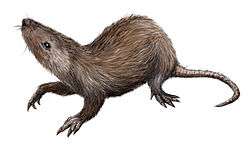Sunnyodon
| Sunnyodon Temporal range: Early Cretaceous | |
|---|---|
 | |
| Restoration | |
| Scientific classification | |
| Kingdom: | Animalia |
| Phylum: | Chordata |
| Class: | Mammalia |
| Order: | Multituberculata |
| Family: | Paulchoffatiidae |
| Genus: | Sunnyodon |
| Species: | S. notleyi |
| Binomial name | |
| Sunnyodon notleyi Kielan-Jaworowska & Ensom, 1992 | |
Sunnyodon is a tiny, extinct mammal, probably of the Lower Cretaceous. Found in what is now southern England, it was a relatively early member of the also extinct order of Multituberculata. It is part of the suborder Plagiaulacida and family Paulchoffatiidae.
The genus Sunnyodon (meaning "Sunny tooth", after Sunnydown Farm) was named by Zofia Kielan-Jaworowska and Ensom P.C. in 1992 based on a single specimen.
Fossil remains of the species Sunnyodon notleyi were found in the Upper Jurassic or Lower Cretaceous-age strata of the Purbeck Formation in Durlston Bay, Dorset, England. This is a tooth-based species. According to P.C. Ensom, this Formation is now considered to be early Lower Cretaceous.
A tooth from the Danish island of Bornholm was assigned to Sunnyodon in 2004. It is the first fossil of a Mesozoic mammal found in Scandinavia.[1]
References
- ↑ Lindgren, J.; Rees, J.; Siverson, M.; Cuny, G. (2004). "The first Mesozoic mammal from Scandinavia". GFF. 126 (4): 325. doi:10.1080/11035890401264325.
Sources
- Kielan-Jaworowska & Ensom (1992), "Multituberculate Mammals from the Upper Jurassic Purbeck Limestone Formation of southern England", Paleontology, 35, p. 95-126.
- Kielan-Jaworowska, Z. & Hurum, J.H. (2001), "Phylogeny and Systematics of multituberculate mammals", Paleontology 44, p. 389-429.